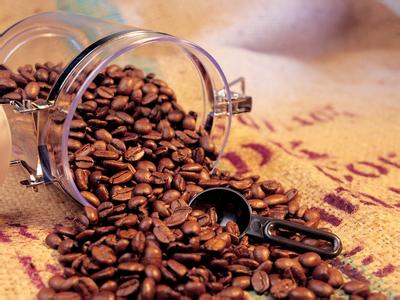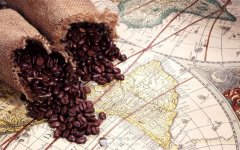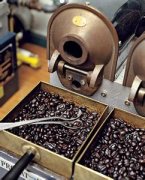Top Blue Mountain Coffee
The Blue Mountains are located in the eastern part of Jamaica Island, surrounded by the Caribbean Sea. Whenever the weather is clear, the sun shines directly on the blue sea, and the peaks reflect the bright blue light of the sea. Therefore, they get their name. Blue Mountain peak elevation of 2256 meters, is the highest peak in the Caribbean, is also a famous tourist attraction. The temperature here is suitable, with fertile volcanic soil, fresh air, no pollution, humid climate, foggy and rainy all year round, providing a perfect environment for the growth of coffee, creating an unparalleled flavor of Blue Mountain Coffee.

Historically, Blue Mountain coffee exports have varied in quality due to the lack of quality standards, greatly affecting its international reputation, until 1943, when Canada, a major importer of Blue Mountain coffee, refused to import Blue Mountain coffee. In order to improve the quality of coffee, the Jamaica government took a series of measures to regulate the coffee industry and established the Jamaica Coffee Industry Board (CIB) in 1948. The Committee sets quality standards for Jamaica coffee and oversees the implementation of quality standards. Each batch of Blue Mountain coffee beans exported will be sampled and tested by quality supervision experts. Only coffee beans meeting the standards can obtain the quality certification issued by the Jamaica Coffee Industry Council.
There are three main types of Jamaica coffee:
Blue Mountain Coffee
Jamaica High Mountain Supreme Coffee Beans
Jamaica Prime washed
The government of Jamaica has a very strict definition of Blue Mountain Coffee:
It must be coffee grown in the Blue Mountains area designated by the Jamaica Coffee Board, processed by a government authorized processing plant and certified by the government. Among them, the Blue Mountain region is defined as a dozen very specific regions of the Blue Mountain Range, mainly distributed in John Crow, St. John's Peak, Mossman's Peak, High Peak, Blue Mountian Peak and other five peaks. At present, there are only six government-designated processing (roasting) plants for Blue Mountain Coffee: WALLENFORD, Mafis River Embankment Central Plant (M.B.C.E.), Blue Mountain Coffee Cooperative Plant (M.H.C.C.T.), Portland Blue Mountain Coffee Cooperative Plant (P.X.X.S.H.), St. John's Peak and J. A.S.
Blue Mountain coffee export classification: No.1, No.2, No.3, Peaberry.
Grading criteria:
No.1 - 17/18 mesh, the proportion of defective beans does not exceed 2%;
No.2 - 16/17 mesh, the proportion of defective beans does not exceed 2%;
No.3 - 15/16 mesh, the proportion of defective beans does not exceed 2%;
Peaberry- 10MS with no more than 2% defective beans;
Note: Coffee usually grown between 457 meters and 1524 meters above sea level is called Alpine Premium Coffee, and coffee grown between 274 meters and 457 meters above sea level is called Jamaica Premium Wash. Coffee in Jamaica was first grown in the hills near Saint Andrew, and then gradually expanded to the Blue Mountain area. At present, St. Angel District is still the main coffee producing area in Jamaica except Blue Mountain. The coffee produced is similar to Blue Mountain and of high quality. However, it is not on Blue Mountain. It is named as Jamaica Prime washed. Its taste is rich and mellow, sour sweet and bitter are balanced and round. The price on the market is quite high. It is also recognized as one of the best products.
All aspects of Blue Mountain coffee production are strictly managed.
Coffee trees are mainly small-sized "Geisha High Bred" type, using mixed planting method, seedlings are cultivated in nurseries for about 2 years, and organic fertilizer is used during growth. The annual harvest period is June to November, and the coffee trees are all grown on rugged hillsides by hand. The picking process is very difficult, and unskilled female workers are simply unable to do it. It is important to choose the right ripe coffee beans at the time of picking. Unripe or ripe coffee can affect the quality of coffee. The beans are shelled the same day and allowed to ferment for 12-18 hours. Coffee beans are then washed and sifted. The next step is drying, which must be carried out on concrete or thick blankets until the humidity of the coffee beans drops to 12%-14%. and then stored in special warehouses. In the green bean processing process, each step has a special person responsible for quality supervision. For the very precious Blue Mountain coffee, the packaging and transportation methods adopted by the Jamaica government are also different. Blue Mountain coffee is not packed and transported in bags like other coffees, but in barrels with a standard of 70 kg/barrel. Jamaica was also the last country to still ship coffee in traditional barrels.
Important Notice :
前街咖啡 FrontStreet Coffee has moved to new addredd:
FrontStreet Coffee Address: 315,Donghua East Road,GuangZhou
Tel:020 38364473
- Prev

Introduction of coffee producing countries
Brazil Santos coffee: produced in South America, Brazil, the output accounts for 35% of the world's first in the world, is an Arab shelf variety, famous for Santos export port, good quality, mild taste, moderate bitterness, soft flavor, is indispensable for the preparation of coffee. Jamaican Blue Mountain Coffee: it is found in the Blue Mountains of Jamaica in the Caribbean, but it can only be called Blue Mountain if it comes from a mountain of 5000 meters.
- Next

Professional knowledge of coffee bean blending
Blending of raw beans requires the use of coffee beans with their own characteristics, and avoid using coffee beans with similar flavor.
Related
- Guji coffee producing area of Guji, Ethiopia: Humbela, Shakiso, Wulaga
- What is the most expensive variety of Qiloso in BOP multi-variety group?
- How to store the coffee beans bought home?
- Why are Yemeni coffee beans so rare now?
- Ethiopian Sidamo all Red Fruit Sun Sun Santa Vini Coffee beans
- SOE is mostly sour? What does it mean? Is it a single bean? what's the difference between it and Italian blending?
- Is Italian coffee beans suitable for making hand-brewed coffee?
- How to choose coffee beans when making cold coffee? What kind of coffee beans are suitable for making cold coffee?
- Just entered the pit to make coffee, what kind of coffee beans should be chosen?
- Can only Japan buy real Blue Mountain Coffee? What are authentic Jamaican Blue Mountain coffee beans?

